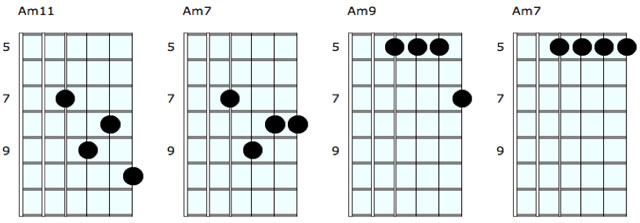Chord Tricks & Funky Grooves: How to make chords interesting!
There are a variety of tricks we can use to make even the most basic chords interesting;
Sometimes, one chord can last for several bars and it needs to be kept alive. In a funky groove there may be only one chord for the duration of the whole verse! So, what can we do? Let’s focus on one chord and make it interesting. All of the examples here will focus on the ‘Am’ chord. However, you can apply these ideas to any other chord.
Chord Inversions
The notes that make up the ‘Am’ chord are A:C:E. They can be played in any order using any combination of strings. Also, as with the open ‘Am’ any of the notes in the chord can be repeated. Here are inversions of ‘Am’ on strings 1, 2 and 3.
Here are ‘Am’ inversions on strings 4, 5 and 6. So, the chord can be played in a variety of positions on the fretboard. Each inversion has a different quality of sound and pitch.

Chord Extensions
Once we know what key the chord is being used in. Any note from that key could be added to extend the chord. Let’s assume that our ‘Am’ is in the key of C major (C:D:E:F:G:A:B:C). The notes of the chord can be extended to ‘Am7’ (A:C:E:G), ‘Am9’ A:C:E:G:B), ‘Am11’ (A:C:E:G:B:D) etc. Now, I’ll play some of these extended chords.
These are the chord extensions I used in the video:

Also, inversions of these extended chords can also be used.
Chord Substitutions
When we’ve extended the chord other chords can be found within it. For example, ‘Am9’ (A:C:E:G:B) contains ‘C’ (C:E:G), ‘Cmaj7’ (C:E:G:B) and ‘Em’ (E:G:B). We could even go down a third and add an ‘F’ below the ‘A’ (F:A:C:E:G:B). This results in ‘Fmaj9#11’, ‘Fmaj9’, ‘Fmaj7’ and ‘F’.
From one chord we now have a series of chords! Here’s what they sound like:
Double stops & octaves
Also, try playing just a couple of notes from any of these chords. In this video I start by using pairs of notes from the ‘Am’ chord. Then I extend these to include notes from the ‘A’ blues scale and finally I add octaves of notes found in the ‘Am7’ chord
Now, think of the possibilities if there were more than one chord! Of course, how you apply these ideas to your rhythm playing needs to fit in with the style of music you’re playing and what the other instruments are doing. I hope you enjoy developing your chord tricks.
Carlos
Article by Carlos Thrale. You can read more from Carlos on his web site: http://www.carlosthrale.com





